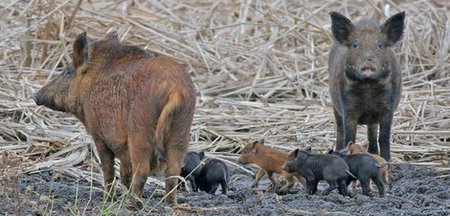Hog hunting is tons of fun, but the practice is as much about feral hog control as the sport of hunting. Wild hogs are not native to the United States. In fact, wild hogs are really feral hogs, hogs that have either escaped from captivity or those that were released into the wild for sport hunting. Of course, the “wildness” of certain hogs depends upon the amount of time they have had to live off the land. With each generation, the hog’s domestic characteristics diminish and they develop the traits needed for survival in the wild. This also makes them more difficult to locate and hunt.
Feral pigs are found in a varity of habitats and range from the east coast to the west coast. Wild hogs will use moist pine forests, arid brush country, and even freshwater and coastal wetlands. Feral hogs are highly adaptable and really are only limited by their need for water because they will eat just about anything they can find, catch, or stumble across. Wild hogs are very opportunisitc feeders and the feral hog diet is based on the seasonal availability of foods. Non-native feral hogs highly compete for a limited food supply with native wildlife, especially white-tailed deer. In short, if you know where the food is, you know where to hunt or trap wild hogs.

Although hogs make use of a varity of habitats they prefer bottomlands with an abundant supply of water, such as rivers, creeks, seeps, and even springs and lakes. If you plan on hunting feral hogs get ready to bust some brush. Wild hogs are generally found in dense cover. Feral pigs are short, but stout, and very strong. They can go in and through places that we would think were inpenetrable.
Depending upon whether you are a hunter or a landowner, you may have enjoyed or cursed feral hogs. They can be great table fare, but they can destroy crops and cause substantial agricultural damage. Because feral hogs are not native to the U.S., most states consider the animals free-ranging livestock, have no closed hunting seasons on them, and no bag limits. Due to these liberal regulations, or lack of any regulation in most cases, hunters enjoy targeting these animals year-round.
So that’s just a little bit about feral hogs and how they live. If you are interested in more information on feral hog food habits, learning how to pattern wild hogs, hunting hogs, or trapping feral hogs, then you have to the right place. Hey, we’ve even got tons of great hog hunting photos and game camera photos, too. This site focuses on feral hog hunting, trapping, and population management. Please look around and don’t hesitate to contact us if you have any questions!